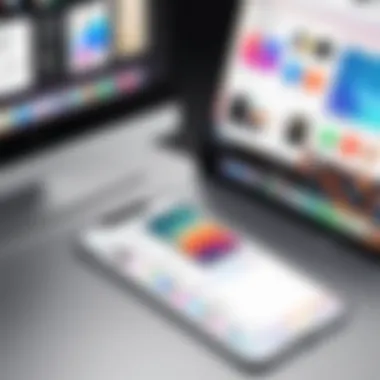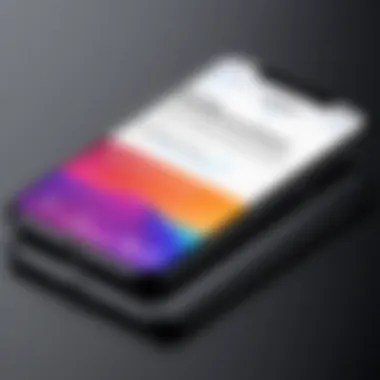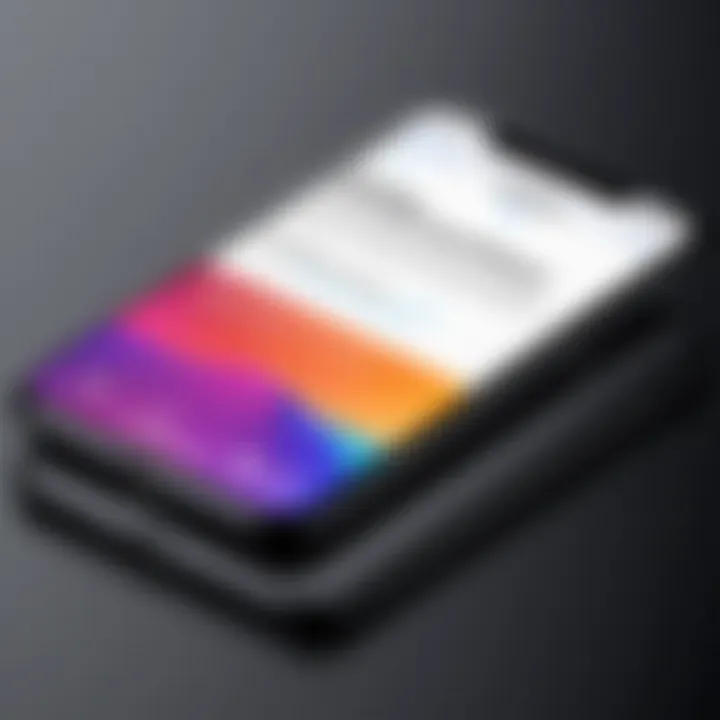Complete Guide to Downloading Apps from the Apple Store


Intro
In today's digital landscape, downloading apps has become second nature to many. Thanks to the widespread use of smartphones and tablets, especially Apple's devices, accessing a vast array of applications is just a few taps away. This guide will walk you through every step, ensuring that you understand the ins and outs of app acquisition from the Apple Store. This isn't just a simple how-to; it offers insight into what to expect, manage, and troubleshoot along the way.
Navigating the Apple Store can feel a bit like diving into a massive ocean of choices. Each app promises to simplify some part of life or enhance your device's capabilities. With a myriad of options available, it’s easy to feel overwhelmed if you don't know where to begin. Hence, our mission is to make this process crystal clear and straightforward.
Product Overview
Preamble to the Apple Store
The Apple Store is often the go-to platform for millions of iPhone and iPad users seeking the latest applications. It's not just a marketplace; it’s a hub for innovation and creativity where developers showcase their talent. The sheer volume of apps available— from games to productivity tools— means there’s something for everyone.
Key Features and Specifications
- User-Friendly Interface: The layout is intuitive and easy to navigate, making it accessible for users across different age groups.
- Categories and Recommendations: Apps are organized into categories like games, education, and health. Additionally, there are personalized recommendations based on your previous downloads and app usage.
- Security and Privacy: Apple prioritizes user security, ensuring that apps are vetted thoroughly before they come to market. This gives users peace of mind while browsing and downloading.
Performance and User Experience
Hands-on Testing
The performance of apps from the Apple Store can greatly vary based on the device and iOS version. However, the majority maintain high quality. Whether you're launching a game or a productivity tool, the user experience remains mostly smooth, provided you have a compatible device.
User Interface and Ease of Use
When it comes to usability, Apple's design philosophy shines through. Users can easily find what they are looking for without unnecessary complexity. Each app page displays essential information, such as ratings, reviews, and compatibility.
Comparison with Similar Products
In contrast to alternatives like Google Play, the Apple Store generally offers a more curated experience. Users often find higher-quality apps with better-integrated features, especially those designed for iOS.
Design and Build Quality
Detailed Analysis
The Apple Store isn’t just about downloading apps; it’s about the entire user experience. The aesthetic appeal and ease of navigation are prioritized. Each listing typically includes appealing visuals and detailed descriptions, helping users make informed choices.
Materials Used and Durability
While the apps themselves have no physical materials, the software design reflects industry standards for performance and durability. The apps are built to last, frequently updated to enhance functionality and security.
Ergonomics and Aesthetics
Apple products are often recognized for their sleek designs, and the Apple Store is no exception. Users enjoy a coherent visual language that aligns with the broader Apple ecosystem.
Technology and Innovation
Groundbreaking Technology
The Apple Store continually evolves, integrating innovative features like augmented reality apps. This shows Apple's commitment to staying at the forefront of technology, promoting applications that push boundaries.
Potential Impact on Consumer Tech
The vast array of creative applications available can influence trends in the tech industry, shaping how users interact with technology daily. Groundbreaking solutions often begin as apps in the Apple Store.
Future Trends
As we look ahead, advancements such as artificial intelligence and machine learning will likely influence app development in the Apple Store. Users can expect continued enhancements that maximize the capabilities of their devices.
Pricing and Value Proposition
Pricing Details
Downloading apps from the Apple Store varies. Many are free, while others are paid or adopt a freemium model. Understanding what you need and how much to spend is crucial.
Value Comparison
When weighing value, it’s essential to consider user experience, support, and regular updates. Many apps in the Apple Store justify their price tags due to robust features and reliability, often setting them apart from competitors with less rigorous vetting processes.
Recommendations and Final Verdict
As a tech-savvy individual navigating the Apple Store for apps, remember that the key lies in balance—finding the functionality that fits your lifestyle while also considering the value offered.
Embrace the opportunity to explore and download apps that resonate with you, knowing you’re investing in quality and security with each download.
Understanding the Apple Store Interface
Navigating the Apple Store is much like learning a new landscape. It has its own quirks and features that, once understood, can turn the experience of downloading apps into a swift and enjoyable process. This section is crucial because it lays the groundwork for users to not just find apps but also to appreciate the thought Apple has put into making the Store intuitive and user-friendly.
Overview of the Home Screen
The home screen of the Apple Store is your launching pad. Here, you’re greets with a clean interface that prioritizes ease of use. The first thing you notice is a row of large banners displaying featured apps, promotions, and updates. These can often highlight seasonal sales or new app releases, which is handy for anyone looking to discover what’s trending.


Right below this, you’ll find a category list that conveniently organizes apps into clusters like Games, Productivity, or Health & Fitness. Having everything clearly laid out saves time. Nobody likes rummaging around for an app that should be a breeze to find.
Moreover, there are usually sections dedicated to top charts and recommendations based on your past downloading behavior. This personalized touch helps you stumble upon apps that you may not have considered before.
Navigating Categories
Jumping into categories is straightforward. With just a tap, users can explore various genres of apps. Each category typically has a ranking system—whether based on popularity, innovation, or user ratings—which can guide potential downloads.
For example, if you're on the lookout for games, sometimes diving into the Gaming category might unveil lesser-known gems that don't get as much spotlight. This might include indie titles or unique multiplayer experiences. Besides, categories often change and refresh, giving space for new apps to shine bright among the well-established ones.
When venturing through these categories, pay attention to not just the icons but also the descriptions. Reading what an app does can easily save you from a regrettable download. Each app listing is accompanied by ratings and reviews from other users, adding another layer of insight into what users might find valuable—or frustrating.
Search Functionality Explained
The search bar is perhaps the most powerful tool on the Apple Store interface. It allows users to cut straight to the chase. Typing in the name of a specific app you have in mind or even broader keywords like "fitness tracking" can yield a plethora of results.
What makes searching effective is the way it predicts results. As you type, you’ll notice suggestions popping up, which can save a lot of time especially if you’re not sure what you are after. Alongside, the search filters can streamline the process. You can sort through free apps, paid apps, or even those offering subscriptions.
Setting Up Your Apple
Establishing an Apple ID is much more than just a routine step—it's the key that unlocks a world of possibilities within the Apple ecosystem. Think of it as the digital master key, giving you access to everything from the App Store to iCloud, Apple Music, and beyond. Having a well-set-up Apple ID means swift access to your favorite apps and services without undue hassle, enhancing your overall experience on your iOS or macOS devices. But what does it take to set up this all-important ID? Let's dive into the nitty-gritty.
Creating an Apple
First things first, to create an Apple ID, it's relatively straightforward and user-friendly. If you're already on your device, head to the Settings app.
- Tap on your name at the top (or ‘Sign in to your iPhone’ if you are not signed in).
- Look for the option that says Create Apple ID and follow the prompts. A few essential inputs will be required:
- Email Address: This will become your Apple ID.
- Password: It’s advisable to create a strong password—think letters, numbers, and a special character or two. Security is paramount.
- Personal Information: You’ll need to provide your name, date of birth, and security questions for account recovery.
After filling everything out, you'll receive a verification email. Don’t forget to click on that link. Otherwise, you’re facing a locked account.
Verifying Your Account
Verification is a necessary hurdle. Once you've created your Apple ID, Apple will send a verification message to the email address you provided. It’s like a secret handshake.
- Open the email from Apple and click the verification link inside. Sometimes, verification emails can take a few minutes to arrive, so don't hit the panic button if it doesn't show up immediately.
- In case you can’t find it, check your spam folder. Sometimes emails can get lost in the shuffle, like a needle in a haystack.
If everything checks out, you're all set. Now your Apple ID is verified, which allows you to access not only the Apple Store but also your purchases, subscriptions, and even your cloud services. Keep your Apple ID information safe and sound. Think of it like the password to your digital vault—without it, things could get sticky.
"Your Apple ID isn't just a username. It's a comprehensive gateway to everything Apple has to offer. Verify it right, and access becomes seamless."
Ensuring your Apple ID is set up correctly is one of the foundational steps in getting the most out of your Apple devices. Do not underestimate its significance; it’s the lifeblood of your device's functionality.
Exploring App Options
When using the Apple Store to download apps, having a clear understanding of the options available is crucial for making informed decisions. The app ecosystem is vast, with an impressive range of functionalities and features. This section delves into the essential elements of app choices, allowing you to navigate the nuances of free, paid, and freemium offerings. Knowing what to expect from each type can not only save you time and money but also provide an overall enhanced experience with your device.
Free vs. Paid Apps
Free apps certainly catch the eye. They offer a tempting zero-dollar price tag, making them an attractive starting point for exploring new functionalities. However, they often come with strings attached. Many free apps are sustained by ads or limited functionality unless you cough up cash for premium features.
Here are some important considerations:
- Functionality: Free apps may provide basic features but could restrict access to advanced options behind a paywall.
- User Interface: Often, free versions might clutter the screen with advertisements, hampering the user experience.
- Support: With free apps, customer service can be spotty. You're in a maze with only minimal guidance.
On the flip side, paid apps usually promise a more seamless experience. For a one-time fee, users can unlock full features, enjoy a more refined interface, and often access better customer support. Consider the following points:
- Investment: Paying for an app can sometimes be seen as investing in quality, resulting in better performance and fewer interruptions.
- Trial Options: Some developers offer free trials of paid apps, allowing you to experience them before the commitment.
- Updates: Paid apps may see more consistent updates and bug fixes, ensuring a more stable experience.
Deciding between free and paid apps often boils down to a personal judgement call. Identify what value you expect and what you’re willing to sacrifice, whether it’s minor inconveniences for free apps or the upfront costs for reliability.
In-App Purchases and Subscriptions
In-app purchases and subscriptions are increasingly common in today’s app landscape, becoming the new normal for many users. Understanding these two models can feel like deciphering a complex puzzle. They are essential to grasp because they can significantly affect how you interact with an app over time.
In-App Purchases enable users to enhance their experience within the app itself. They can range from buying virtual goods in gaming apps to accessing premium features in productivity tools. Here are some key points on this model:
- One-Time vs. Recurring Payments: Buy what you need once for a flat fee or enjoy a subsequent stream of purchases. Know your budget and how deeply into an app you want to go.
- Pressure to Buy: Certain apps may feel like they nudge you toward spending more. Players in games, for instance, might find themselves in a cycle of 'buy to progress.'
- Unlocks vs. Progression: Understand whether in-app purchases are merely cosmetic or if they genuinely affect your app's functionality.
Subscriptions are often more consistent and can provide regular updates and new content. This model becomes increasingly popular with apps that require ongoing service, like streaming services or fitness applications. Consider this:
- Ongoing Cost: Unlike a one-off purchase, subscriptions create a recurring expense. Evaluate if the monthly fee aligns with your usage and lifestyle.
- Value Over Time: Some subscriptions offer added value by continuously updating content and features, increasing their worth.
- Trial Periods: Look for those initial offers to test the waters. A free trial can be an excellent way to assess whether the paid subscription provides adequate value.
Managing how and when you decide to invest in purchases or subscriptions can shape your overall user experience. It’s vital to keep track of what you’ve signed up for and how it aligns with your interests, ensuring that you don’t end up footin’ the bill for services not being utilized.
"In this mobile-driven age, keeping your digital expenditures in check is as necessary as balancing a checkbook. Choose wisely and consider the long-term benefits."
With a clearer understanding of the options at hand, users can make more informed choices about which apps suit their needs and budget. Whether by weighing the benefits of free versus paid apps or deciding on in-app purchases and subscriptions, the right choices can enhance your Apple Store experience exponentially.
Downloading Apps on iOS Devices
Downloading apps on iOS devices is a cornerstone of using the Apple ecosystem effectively. In a world dominated by digital experiences and functionalities, having the right applications can make or break how one navigates their tech life. Whether you're a student, professional, or just someone looking to stay connected, the apps you choose can enhance productivity, creativity, and entertainment. Understanding how to download apps seamlessly is imperative, and doing it right can save a whole lot of headaches down the line.


Step-by-Step Download Instructions
To get started with downloading apps on your iOS device, whether it's an iPhone or an iPad, follow these steps:
- Unlock Your Device: Make sure your device is powered on and unlocked.
- Open the App Store: Locate the App Store icon on your home screen and tap it to launch.
- Explore or Search: You can either browse the featured apps and categories or use the search bar at the bottom of the screen to type in the name of the app you're looking for.
- Select the App: When you find the app you want, tap on it to see more details, including description, reviews, and screenshots.
- Tap the "Get" Button: If it's a free app, tap the "Get" button. For paid apps, that button will show the price.
- Authenticate: You may be prompted to enter your Apple ID password, use Face ID, or Touch ID to confirm the download.
- Downloading in Progress: After confirmation, the app will begin to download. You'll see a circular progress indicator next to the app icon.
- Open the App: Once the download is complete, tap "Open" or find it on your home screen and start using it right away.
These steps are straightforward, yet essential, allowing users to easily access an array of functionalities that the Apple ecosystem offers.
Managing App Downloads
Managing app downloads can be just as important as the actual downloading process. Here are a few key points to consider:
- Monitor Your Storage: Regularly check your device's storage settings to ensure you have enough space for downloads. Go to Settings > General > iPhone Storage to see what's taking up space.
- Prioritize Downloads: If you're downloading several apps simultaneously, prioritize which apps are more crucial and pause or cancel others. This can prevent unnecessary delays.
- Update Regularly: Keep your apps up-to-date for optimal performance and security. Automatic updates can be enabled in Settings under the App Store section.
- Reinstall Deleted Apps: If you ever find yourself needing an app you deleted, simply search for it in the App Store again and download it without any hassle.
"Organizing your app downloads not only streamlines your device's performance but also enhances your overall user experience."
Although app downloading on iOS devices is typically smooth, being aware of these management tips can save you time and frustration, allowing you to make the most of the apps you've chosen.
Downloading Apps on macOS
When you’re diving into the world of downloading apps on macOS, it’s a different ballgame compared to iOS. The Apple Store on your Mac offers a rich experience tailored for larger screens, more powerful hardware, and versatility. Whether you're fetching the latest productivity tool or a game to pass the time, understanding how the process works can enhance your interaction with software applications.
Using the Apple Store on Mac
Navigating the Apple Store on your Mac is quite user-friendly. You open the store and are greeted with an array of applications curated just for you. You can easily browse through software by category, or check out the top charts featuring popular applications. It’s just like window shopping, but in the comfort of your own home.
A few things to note:
- Application Layout: Apps are meticulously arranged on the dashboard. Some categories include productivity, games, creativity, and utilities.
- Featured Apps: There are sections for new releases, editor's choice, and trending apps that make it easy to discover what’s hot right now.
- User Reviews: Ratings and reviews are pivotal in helping you decide which apps to trust. Read what other users say before pulling the trigger on a download.
Here’s how to launch the Apple Store on your Mac:
- Click on the Apple icon on the top left corner of your screen.
- Select App Store from the drop-down menu.
- You can begin exploring applications right away!
"The Apple Store on macOS is not just a marketplace; it's a gateway to enhancing productivity and discovering creativity across various applications."
Downloading Services via Finder
Sometimes, you might require a specific service or application that may not be available directly from the Apple Store; downloading services via Finder can cover your needs in such cases. Each file in Finder is an opportunity, perhaps to install software from a third-party source or to grab application installers that enhance functionality.
To access an application file using Finder:
- Open Finder by clicking the face icon in your Dock.
- Navigate to the Downloads folder, or if you have saved the file elsewhere, pursue the pathway to that folder.
- Locate the .dmg file for your application. Double-clicking this file should mount it as a new disk on your desktop.
- Follow any installation instructions provided on your screen.
While this approach can be beneficial, it’s crucial to acknowledge some important factors:
- Be sure you’re downloading from a trusted source. Stray too far from the well-trodden path, and you may run the risk of installing malicious software.
- Keep your system updated to avoid compatibility issues when running these additional applications.
- Not all applications downloaded this way will integrate seamlessly into the Apple ecosystem.
App Updates and Maintenance
Maintaining your apps is as crucial as getting them in the first place. App updates not only introduce fresh features but also patch any security vulnerabilities that may have cropped up since the last update. This is essential to keep your experience smooth and enjoyable, especially when using third-party apps, which can often have more bugs than Apple’s in-house offerings. Regularly updating apps is like tending to a garden: neglect it, and you’ll find weeds sprouting up, affecting the health of all the flowers.
Understanding how updates work can significantly enhance your experience with the Apple Store. There are two routes you can take: you can manually update apps whenever you choose, or you can let the system do its magic and update them automatically. Let’s dig a little deeper.
Manual vs. Automatic Updates
When it comes to updating apps, you basically have the choice between two options: automatic updates or manual updates. Automatic updates can be set up so that your apps will refresh without you lifting a finger. This is like having a digital assistant that keeps your apps shiny and up-to-date while you go about your day. Just ensure your Wi-Fi and battery settings can handle it, otherwise, you might face some interruptions.
On the flip side, manual updates give you more control. This means you can pick and choose which apps to update and when. If you’re a bit of a control freak, this might be more your speed. Here’s how you can update apps manually:
- Open the App Store.
- Tap on your profile icon. This will bring you to your account settings.
- Scroll to see available updates. Here, you can see which apps have updates pending.
- Tap ‘Update’ next to the app to refresh it.
- Or, if you want to do them all at once, tap ‘Update All.’
"An update isn't just a pit stop; it can be a turn towards better performance and security. Regular updates help in maintaining a robust experience.”
It's great when technology takes the hassle out of things, right? But do keep in mind that frequent updates can sometimes lead to compatibility issues or new bugs, so be sure to check user feedback before hitting that 'Update' button.
Troubleshooting Update Issues
Sometimes, things don’t go as planned. Update problems can arise for various reasons, from storage issues to connectivity problems. Understanding common issues can help you avoid pitfalls and keep your apps in top shape.
Common Problems:
- Storage Space: If your device is low on space, updates may fail to install. Regularly check your storage settings to ensure there's enough room for those new updates.
- Network Connectivity: Slow or unstable internet can be a troublemaker. If you find updates lagging or failing, a stable Wi-Fi connection is a must.
- App Compatibility: Sometimes, the latest update might not be compatible with your device’s software version. Always check device requirements before updating.
Solutions:
- Free Up Space: Consider deleting apps you no longer use, especially those that take up a lot of space.
- Switch Networks: If you’re stuck on a slow connection, switch to a faster network when possible.
- Restart Your Device: This often clears out bugs that may be causing issues with updates.
If you encounter persistent problems beyond these basics, don’t hesitate to reach out to Apple Support. They’ve got the tools to help sort out issues you might face when conducting updates, ensuring you stay on track with your app experience.
Managing Storage Space for Apps


Managing storage space for apps is essential for any user interacting with the Apple Store. We live in a world where applications have become integral to our daily routines, powering everything from productivity to entertainment. However, as we accumulate apps, storage can become tight, leading to performance issues and a cluttered experience. Thus, understanding how to efficiently manage storage can transform your device from a slowpoke into a high-functioning ally in your tech arsenal.
This section dives deep into two critical aspects: assessing available storage and deleting apps to free up space. By mastering these techniques, you gain the ability to keep your device running smoothly and maintain access to the apps that matter most.
Assessing Available Storage
Before you can free up space, it is crucial to know where you stand regarding storage capacity. Evaluating available storage on your device is a simple but impactful action. Not only does it tell you how much space you have left, but it also provides insights into which data hogs are taking valuable real estate.
To check available storage on your iOS device, navigate to the Settings app:
- Open the Settings app
- Tap on General
- Select iPhone Storage (or iPad Storage if you are using an iPad)
Here, you’ll see a visual representation of used and available space along with a list of apps sorted by how much storage they consume. This information is incredibly useful for identifying potential culprits and makes prioritizing which apps to keep or delete much clearer.
Deleting Apps to Free Up Space
Once you have assessed your available storage, the next step is often to delete unnecessary apps. This might seem like an easy solution, but many users struggle with the decision to let go of an app. Nonetheless, there comes a time when freeing up space becomes necessary.
Here’s how to delete apps effectively on your device:
- Long Press: You can simply long-press any app icon on your home screen. A menu will appear, allowing you to choose Remove App or Delete App.
- Settings Approach: Alternatively, you can delete apps via the Settings app. Head back to Settings > General > iPhone Storage, and select the app you want to delete. From there, tap on Delete App.
Consider these factors while deleting apps:
- Frequency of Use: If you haven’t used an app in months, it's probably time to say goodbye.
- Apps of Duplicate Function: Evaluate if you have multiple apps performing similar actions. For instance, if you have several photo editing apps, choose your favorite and delete the rest.
- Temporary Apps: Some apps are only needed for specific tasks, such as buying tickets or ordering food. Once the task is complete, consider removing these to free up space.
“Less is more” is a philosophy that rings true in the realm of app management. You may find that having fewer well-chosen apps enhances your experience more than a plethora of seldom-used ones.
In a tech-savvy age, understanding the storage aspect of app management can significantly affect the performance of your devices. Making informed decisions about which apps to keep and which to let go of not only enhances your device's speed but also improves your overall user experience.
Security Considerations
In today’s digital age, the security of applications you download is paramount. The Apple Store is considered a relatively safe environment for obtaining apps, but that doesn’t negate the need for users to remain vigilant. Users should be aware of potential risks associated with app downloads. Understanding security considerations helps in making informed decisions, ensuring not only a smooth experience but also protection against malicious content and data breaches. It’s not just about downloading an app; it’s about safeguarding yourself and your data.
Ensuring App Integrity
Checking the integrity of apps from the Apple Store involves several key factors. Firstly, users need to be aware of the app’s source. All apps listed on the Apple Store are vetted by Apple to some degree, but that doesn’t mean you should download on a whim. Look out for:
- User reviews: Go through user feedback before hitting that download button. Reviews can provide insights about the app’s performance and reliability.
- Developer’s reputation: Familiarizing yourself with the developer behind an app can give you a sense of trust. Known developers generally have an established track record.
- Regular updates: An app that is regularly updated is usually a good sign. It indicates that developers are committed to maintaining security and improving functionality.
When you consider these factors, you're not just downloading technology, you're making a safer choice for your mobile device.
Understanding Data Privacy
Data privacy has emerged as a major concern for users navigating the digital landscape. Most apps solicit permissions to access personal data or device functionality. It’s crucial to know what permissions you’re granting, to whom, and why.
Here are some best practices to consider for understanding data privacy:
- Read privacy policies: While these can often feel like a wall of legalese, take a moment to skim through them. They outline how your information is collected and used.
- Limit permissions: Only allow access to the data that is functionally necessary for the app. If a weather app requests access to your contacts, that might raise a red flag.
- Utilize privacy settings: Customize your device’s privacy settings to control what you share. Apple collects information to improve user experience, but users can opt out of many data collection methods.
"Being conscious about your data is being conscious about your digital footprint."
Troubleshooting Download Problems
Downloading apps from the Apple Store should ideally be a seamless process. Yet, many users encounter hiccups along the way, leading to frustration. Understanding the common download issues and knowing how to address them enhances user experience greatly. This section delves into the typical snags one might hit when trying to obtain apps, and provides guidance not just on fixing these problems, but on recognizing when to escalate an issue to Apple Support.
Common Download Issues
When your fingers are itching to try out a new app, waiting on a download can feel like watching grass grow. Here are some of the frequent download issues you might encounter:
- Slow or Stalled Downloads: Sometimes, downloads take forever, or they’re stuck at the same percentage. This might be due to a weak internet connection. A quick check of your Wi-Fi or cellular data can be a real lifesaver here.
- Incompatible Apps: Often, users might find that an app won't download because it isn’t compatible with their device. Checking the app’s requirements beforehand can save you time.
- Insufficient Storage: You might think you’ve got enough storage, but hidden files can eat up space. Always double-check your device's available storage before downloading.
- Updates Needed: Some apps simply refuse to budge until your operating system is updated. Make sure your device is running the latest version of iOS or macOS.
- Account Issues: If there's something amiss with your Apple ID, you won't be able to download anything. Always ensure your Apple ID is up to date and correctly configured.
"An ounce of prevention is worth a pound of cure"—keeping these potential issues in mind can spare you from a whole lot of hassle.
Contacting Apple Support
In the age of digital everything, having prompt access to help is crucial. If you've pursued all self-help avenues and the app still refuses to download, it might be time to contact Apple Support. Here’s when and how to reach out:
- When to Contact: If none of the troubleshooting steps work or if persistent issues affect multiple apps, it’s clear that professional help is warranted. Apple Support can delve into known issues or guide you through complex fixes specific to your device or account.
- How to Contact: You can reach Apple Support through various channels:
- Phone: Call their dedicated customer service number available on the Apple website.
- Online Chat: An option for those who prefer not to talk over the phone. Simply navigate to the Apple Support page and initiate a chat with a specialist.
- Apple Support App: If you’ve got the app installed, you can get personalized assistance right from your device.
- In-Person Visits: For those who prefer face-to-face interaction, scheduling a Genius Bar appointment at your local Apple Store can yield hands-on help.
In summary, while downloading apps should be trouble-free, it’s essential to be prepared for possible issues and know when to ask for help. Whether it’s a simple connectivity hiccup or deeper complications, navigating the Apple Store with these insights will surely smooth the ride.
Finale
In wrapping up this guide, it’s evident that understanding the download process from the Apple Store is not just about clicking buttons. It encompasses a multitude of factors, from the nuances of account management to troubleshooting unexpected hiccups. Embracing this knowledge empowers users, ensuring they can navigate the ecosystem confidently and with clarity.
Key Takeaways for Users
Several essential points stand out:
- Familiarize yourself with the interface: Knowing where to find app categories and utilize the search function can save precious time.
- Security is paramount: Always verify app authenticity and be mindful of permissions requested during installation.
- Managing storage effectively: Assessing and clearing up space is crucial, particularly if you commonly download large applications or games.
- Stay updated: Regularly checking for app updates not only keeps your apps functioning smoothly but also ensures you aren't missing out on new features or critical security patches.
Future of App Downloads on Apple Store
Looking ahead, the landscape of app downloading is poised to evolve further. With trends leaning towards subscription models and cloud-based applications, users may find themselves exploring choices that align more closely with their individual needs. The integration of more personalized recommendations driven by AI could revolutionize how users discover new apps. Furthermore, developments in augmented reality (AR) and virtual reality (VR) may pave the way for entirely new types of applications, changing the way we interact with technology every day.
As we adopt newer devices and operating systems, the Apple Store will likely become an increasingly central hub for managing our digital lives, blending functionality with cutting-edge innovations. This will enable both the casual user and technology enthusiasts to find what they need efficiently and safely—further cementing Apple’s place in the hearts of gadget lovers everywhere.



